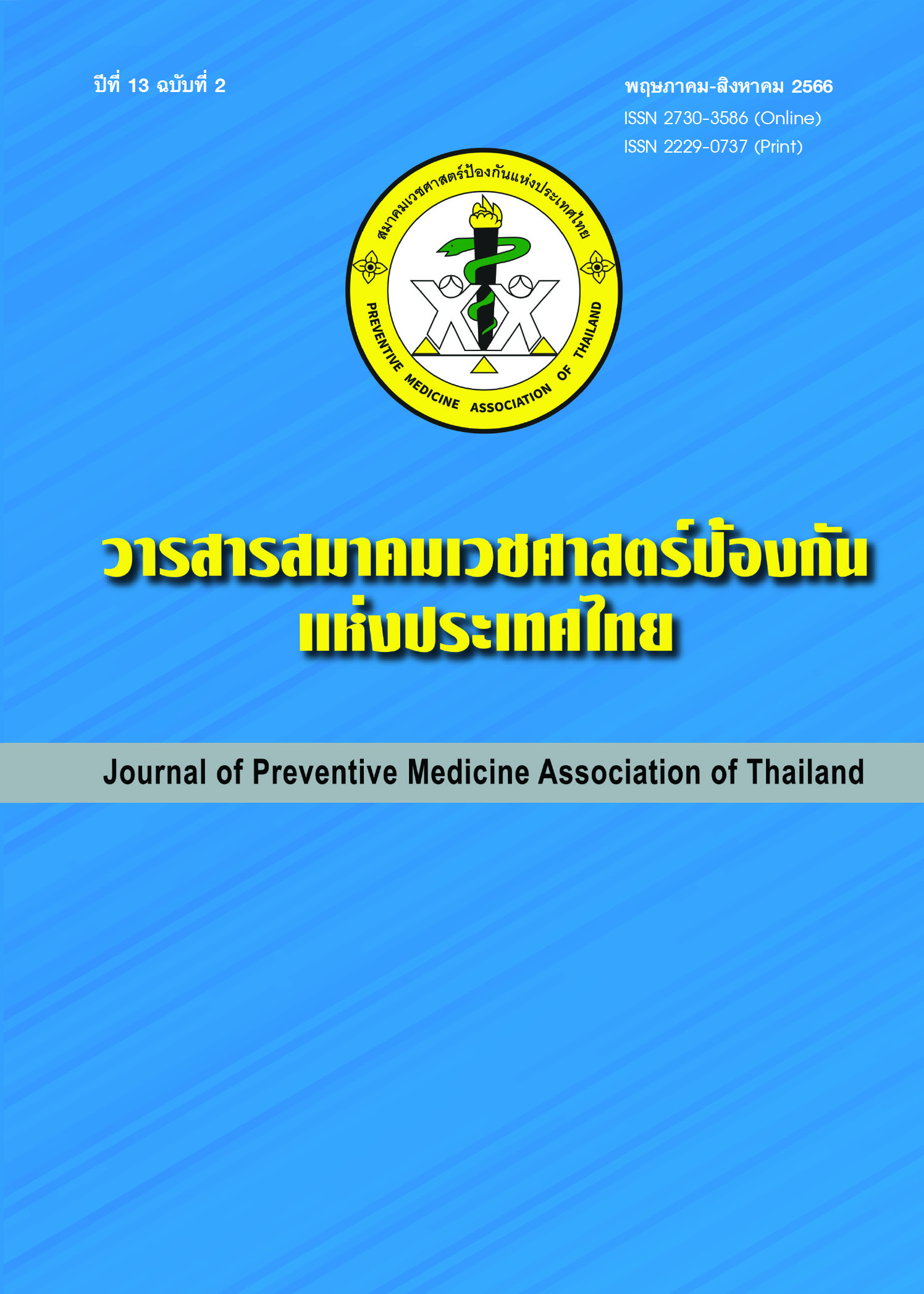สารทำความสะอาดและโรคหืดจากการทำงาน
คำสำคัญ:
สารทำความสะอาด, โรคหืดจากการทำงานบทคัดย่อ
การสัมผัสสารทำความสะอาดเป็นหนึ่งในสาเหตุสำคัญของการเกิดโรคหืดจากการทำงาน การศึกษาทางระบาดวิทยาหลายการศึกษาพบว่าสารทำความสะอาดหลายชนิดสัมพันธ์กับการเกิดโรคหืด สารก่อโรคหืดที่พบได้ในสารทำความสะอาดมีทั้ง 1) สารก่อภูมิแพ้ เช่น สารประกอบควอเทอร์นารีแอมโมเนียมและกลูตารัลดีไฮด์ และ 2) สารระคายเคือง เช่น สารฟอกขาว โดยพบว่าอาชีพที่เป็นกลุ่มเสี่ยงในการสัมผัส ได้แก่ พนักงานทำความสะอาด และบุคลากรทางการแพทย์ โดย ปัจจัยเสี่ยงด้านการทำงาน ได้แก่ การใช้สเปรย์ทำความสะอาดและระยะเวลาในการทำงาน โรคหืดจากการทำงานเป็นโรคที่สามารถป้องกันได้ การศึกษาข้อมูลเกี่ยวกับสารก่อโรคหืดในสารทำความสะอาดจะช่วยในการกำหนดมาตรการป้องกันโรคและการเฝ้าระวังสุขภาพได้อย่างเหมาะสม
เอกสารอ้างอิง
Feary J, Suojalehto H, Cullinan P, editors. Occupational and environmental lung disease. Sheffield, UK: European Respiratory Society; 2020.
GBD 2016 Occupational Chronic Respiratory Risk Factors Collaborators. Global and regional burden of chronic respiratory disease in 2016 arising from non-infectious airborne occupational exposures: a systematic analysis for the Global Burden of Disease Study 2016. Occup Environ Med 2020;77(3):142-50.
Reilly MJ, Wang L, Rosenman KD. The burden of work-related asthma in Michigan, 1988-2018. Ann Am Thorac Soc 2020;17(3):284-92.
Walters GI, Kirkham A, McGrath EE, Moore VC, Robertson AS, Burge PS. Twenty years of SHIELD: decreasing incidence of occupational asthma in the West Midlands, UK? Occup Environ Med 2015;72(4):304-10.
Global Initiative for Asthma. Global strategy for asthma management and prevention (2021 update) [Internet]. 2021 [cited 2022 Nov 24]. Available from: https://ginasthma.org/wp-content/uploads/2021/05/GINA-Main-Report-2021-V2-WMS.pdf.
Hoy R, Burdon J, Chen L, Miles S, Perret JL, Prasad S, et al. Work-related asthma: a position paper from the Thoracic Society of Australia and New Zealand and the National Asthma Council Australia. Respirology 2020;25(11):1183-92.
Malo JL, Vandenplas O. Definitions and classification of work-related asthma. Immunol Allergy Clin North Am 2011;31(4):645-62.
Maestrelli P, Boschetto P, Fabbri LM, Mapp CE. Mechanisms of occupational asthma. J Allergy Clin Immunol 2009;123(3):531-42.
Dao A, Bernstein DI. Occupational exposure and asthma. Ann Allergy Asthma Immunol 2018;120(5):468-75.
Cullinan P, Vandenplas O, Bernstein D. Assessment and management of occupational asthma. J Allergy Clin Immunol Pract 2020;8(10):3264-75.
Rosenman KD, Reilly MJ, Schill DP, Valiante D, Flattery J, Harrison R, et al. Cleaning products and work-related asthma. J Occup Environ Med 2003;45(5):556-63.
Siracusa A, De Blay F, Folletti I, Moscato G, Olivieri M, Quirce S, et al. Asthma and exposure to cleaning products - a European Academy of Allergy and Clinical Immunology task force consensus statement. Allergy 2013;68(12):1532-45.
Zock JP. World at work: cleaners. Occup Environ Med 2005;62(8):581-4.
Archangelidi O, Sathiyajit S, Consonni D, Jarvis D, De Matteis S. Cleaning products and respiratory health outcomes in occupational cleaners: a systematic review and meta-analysis. Occup Environ Med 2021;78:604-17.
Starke KR, Friedrich S, Schubert M, Kampf D, Girbig M, Pretzsch A, et al. Are healthcare workers at an increased risk for obstructive respiratory diseases due to cleaning and disinfection agents? A systematic review and meta-analysis. Int J Environ Res Public Health 2021;18(10):5159.
Dang KTL, Garrido AN, Prasad S, Afanasyeva M, Lipszyc JC, Orchanian-Cheff A, et al. The relationship between cleaning product exposure and respiratory and skin symptoms among healthcare workers in a hospital setting: a systematic review and meta-analysis. Health Sci Rep 2022;5(3):e623.
Zock JP, Plana E, Jarvis D, Anto JM, Kromhout H, Kennedy SM, et al. The use of household cleaning sprays and adult asthma: an international longitudinal study. Am J Respir Crit Care Med 2007;176(8):735-41.
Svanes O, Skorge TD, Johannessen A, Bertelsen RJ, Bratveit M, Forsberg B, et al. Respiratory health in cleaners in Northern Europe: Is susceptibility established in early life? PLoS One 2015;10(7):e0131959.
Gonzalez M, Jegu J, Kopferschmitt MC, Donnay C, Hedelin G, Matzinger F, et al. Asthma among workers in healthcare settings: role of disinfection with quaternary ammonium compounds. Clin Exp Allergy 2014;44(3):393-406.
Walters GI, Burge PS, Moore VC, Robertson AS. Cleaning agent occupational asthma in the West Midlands, UK: 2000–16. Occup Med (Lond) 2018;68(8):530-6.
Migueres N, Debaille C, Walusiak-Skorupa J, Lipinska-Ojrzanowska A, Munoz X, van Kampen V, et al. Occupational asthma caused by quaternary ammonium compounds: a multicenter cohort study. J Allergy Clin Immunol Pract 2021;9(9):3387-95.
Quirce S, Barranco P. Cleaning agents and asthma. J Investig Allergol Clin Immunol 2010;20(7):542-50.
Paris C, Ngatchou-Wandji J, Luc A, McNamee R, Bensefa-Colas L, Larabi L, et al. Work-related asthma in France: recent trends for the period 2001-2009. Occup Environ Med 2012;69(6):391-7.
Di Stefano F, Siriruttanapruk S, McCoach J, Sherwood Burge PS. Glutaraldehyde: an occupational hazard in the hospital setting. Allergy 1999;54(10):1105-9.
Ong TH, Tan KL, Lee HS, Eng P. A case report of occupational asthma due to gluteraldehyde exposure. Ann Acad Med Singap 2004;33(2):275-8.
Chan-Yeung M, McMurren T, Catonio-Begley F, Lam S. Occupational asthma in a technologist exposed to glutaraldehyde. J Allergy Clin Immunol 1993;91(5):974-8.
Di Stefano F, Siriruttanapruk S, McCoach J, Di Gioacchino M, Burge PS. Occupational asthma in a highly industrialized region of UK: report from a local surveillance scheme. Eur Ann Allergy Clin Immunol 2004;36(2):56-62.
Dumas O, Le Moual N. Do chronic workplace irritant exposures cause asthma? Curr Opin Allergy Clin Immunol 2016;16(2):75-85.
Tarlo SM, Lemiere C. Occupational asthma. N Engl J Med 2014;370(7):640-9.
Brooks SM, Hammad Y, Richards I, Giovinco-Barbas J, Jenkins K. The spectrum of irritant-induced asthma: sudden and not-so-sudden onset and the role of allergy. Chest 1998;113(1):42-9.
Lemiere C, Lavoie G, Doyen V, Vandenplas O. Irritant-induced asthma. J Allergy Clin Immunol Pract 2022;10(11):2799-806.
Benzoni T, Hatcher JD. Bleach Toxicity. Treasure Island (FL): StatPearls Publishing; 2022.
Matulonga B, Rava M, Siroux V, Bernard A, Dumas O, Pin I, et al. Women using bleach for home cleaning are at increased risk of non-allergic asthma. Respir Med 2016;117:264-71.
ดาวน์โหลด
เผยแพร่แล้ว
รูปแบบการอ้างอิง
ฉบับ
ประเภทบทความ
สัญญาอนุญาต
ลิขสิทธิ์ (c) 2023 วารสารสมาคมเวชศาสตร์ป้องกันแห่งประเทศไทย

อนุญาตภายใต้เงื่อนไข Creative Commons Attribution-NonCommercial-NoDerivatives 4.0 International License.
บทความที่ลงพิมพ์ในวารสารเวชศาสตร์ป้องกันแห่งประเทศไทย ถือเป็นผลงานวิชาการ งานวิจัย วิเคราะห์ วิจารณ์ ตลอดจนเป็นความเห็นส่วนตัวของผู้นิพนธ์ กองบรรณาธิการไม่จำเป็นต้องเห็นด้วยเสมอไป และผู้นิพนธ์จะต้องรับผิดชอบต่อบทความของตนเอง






